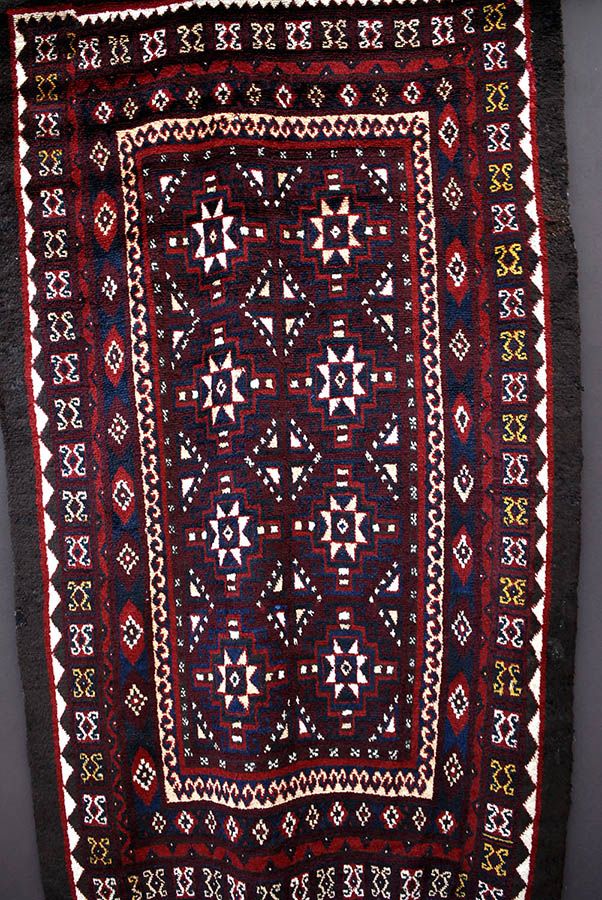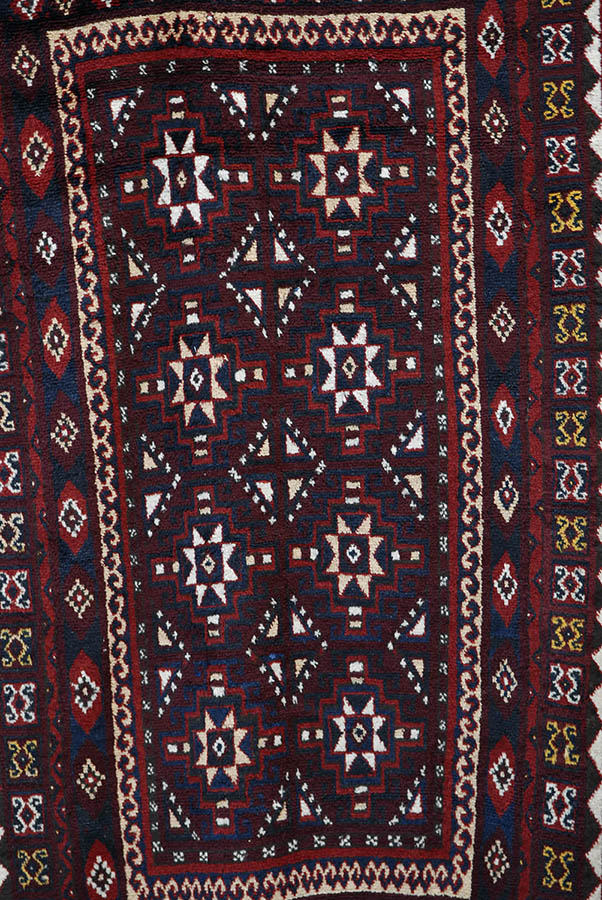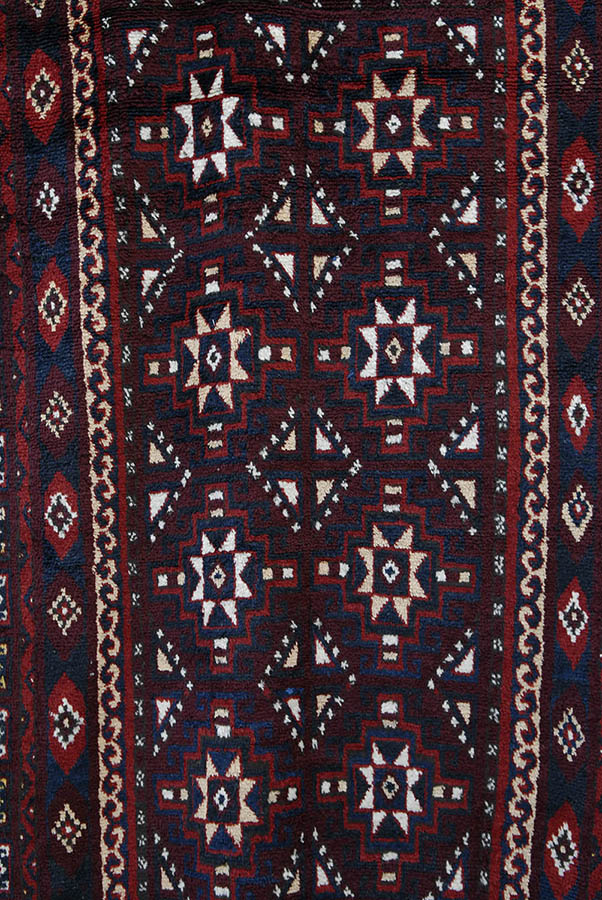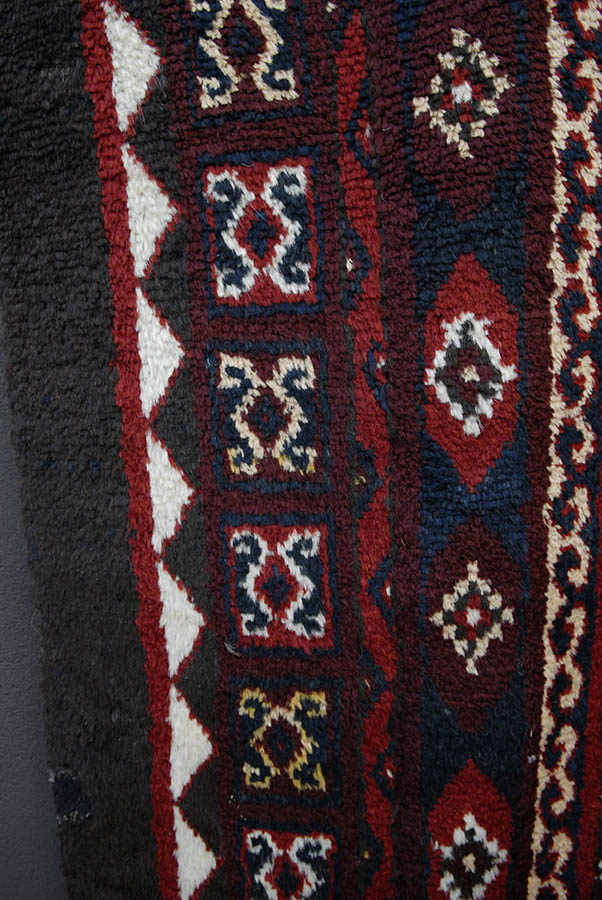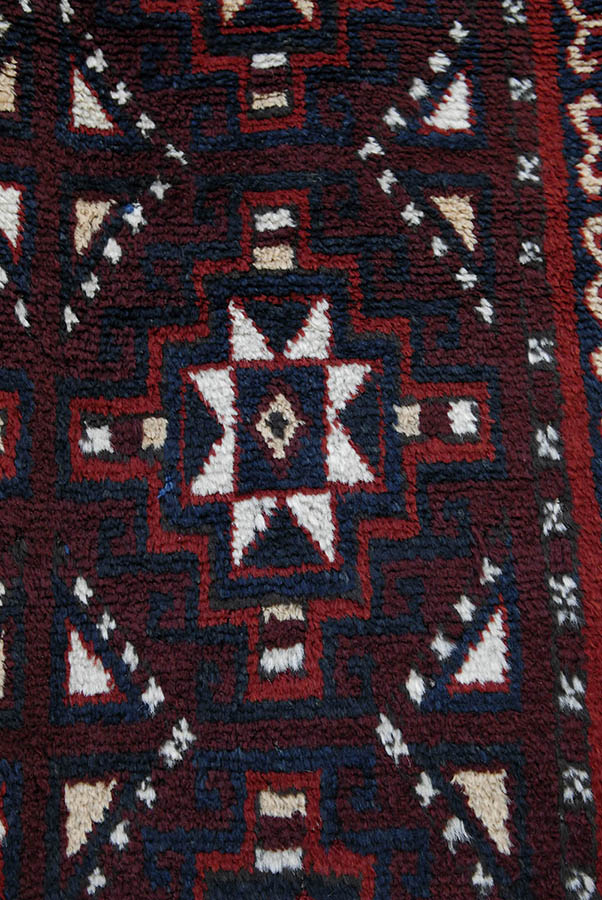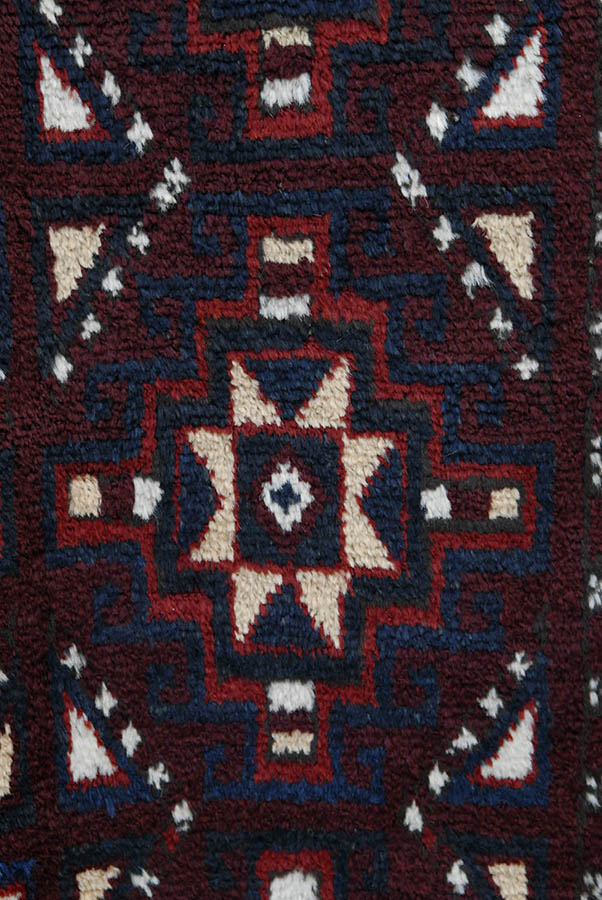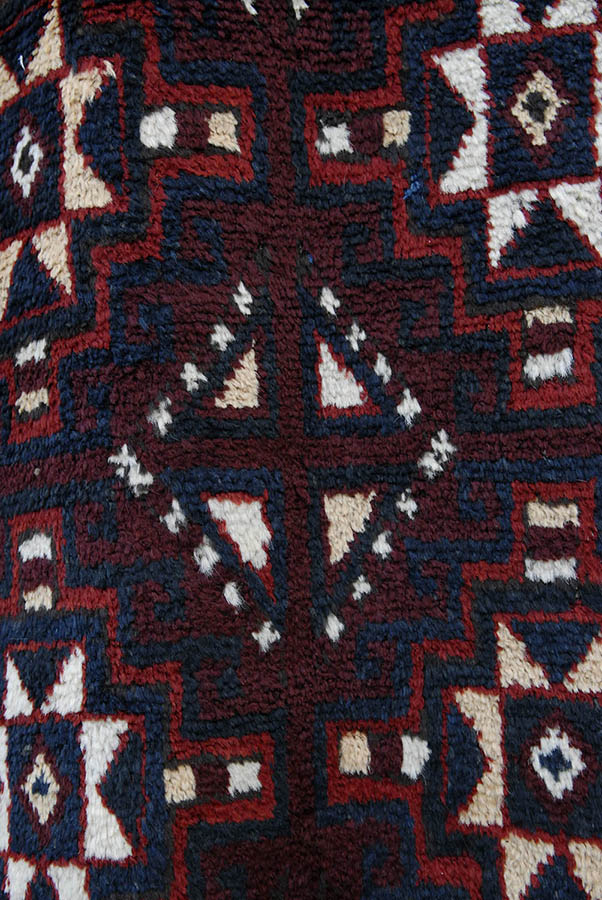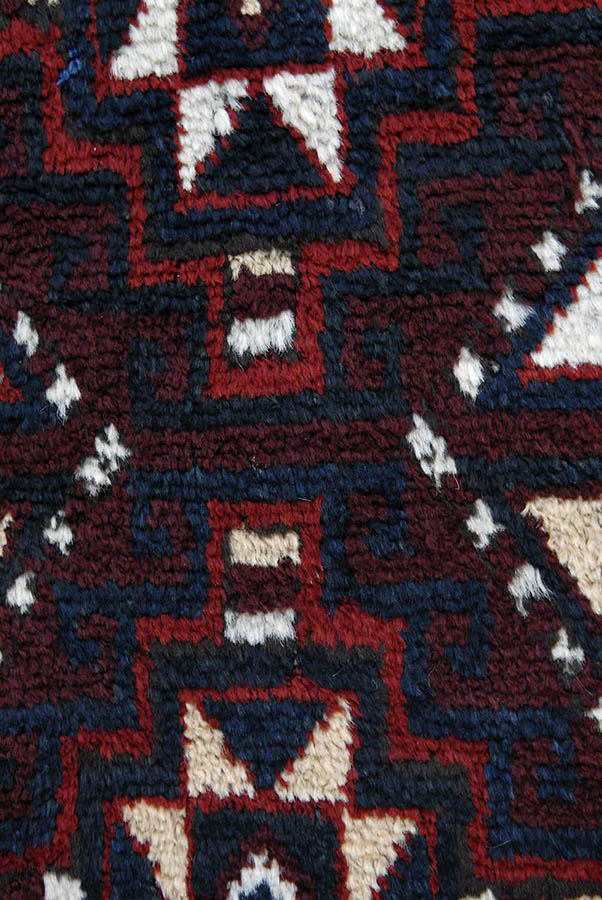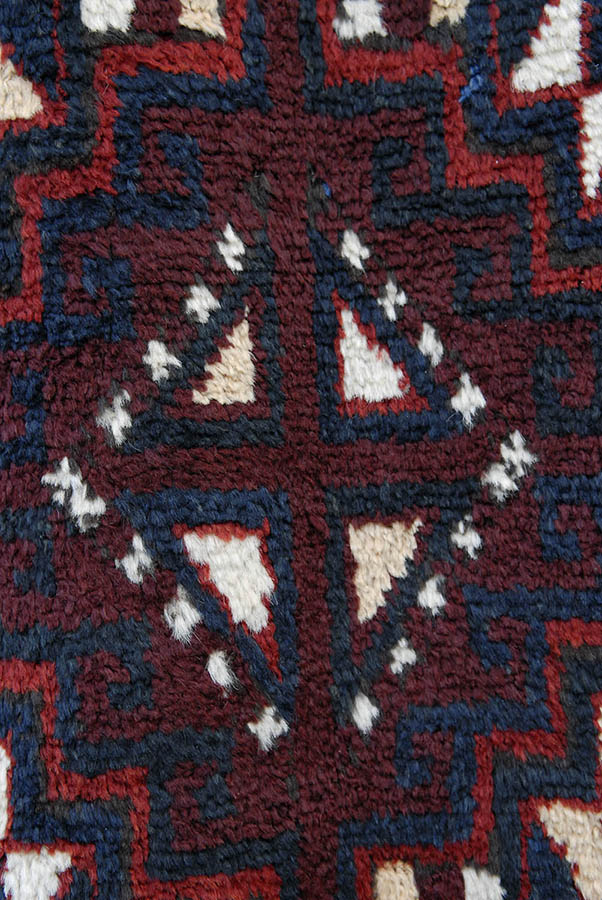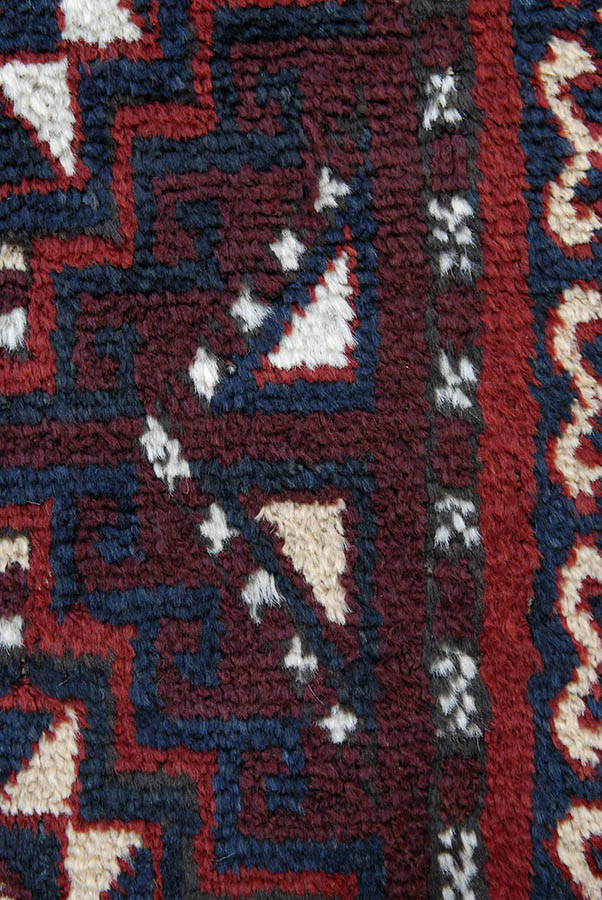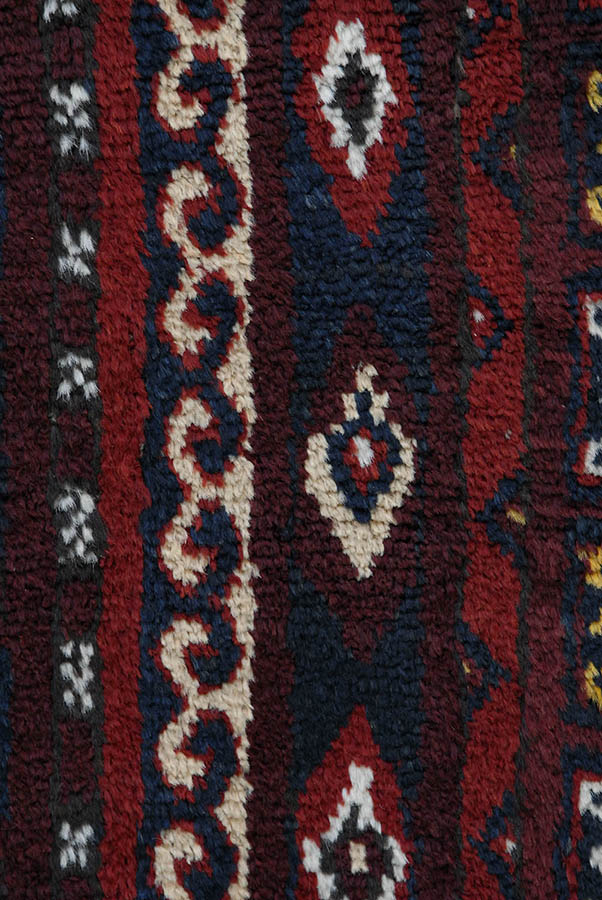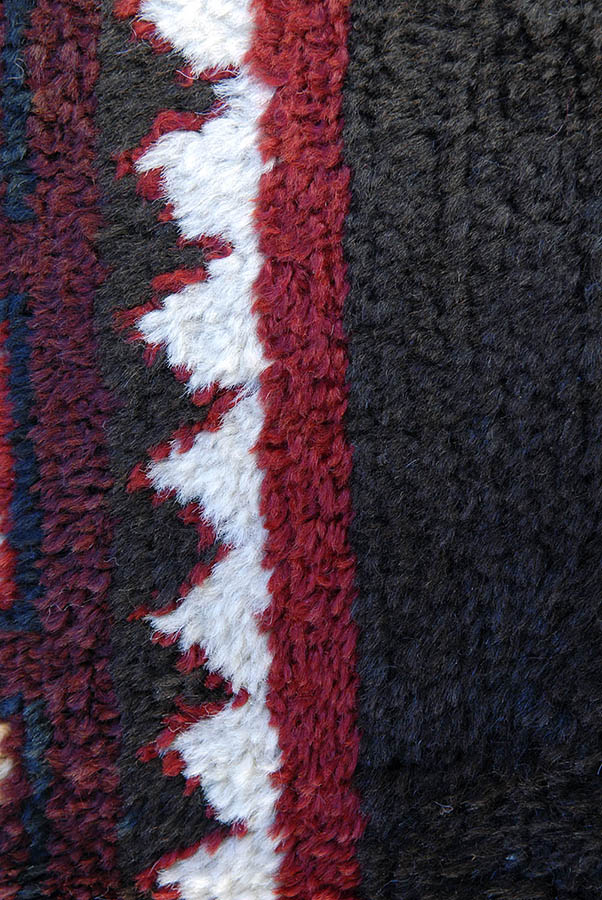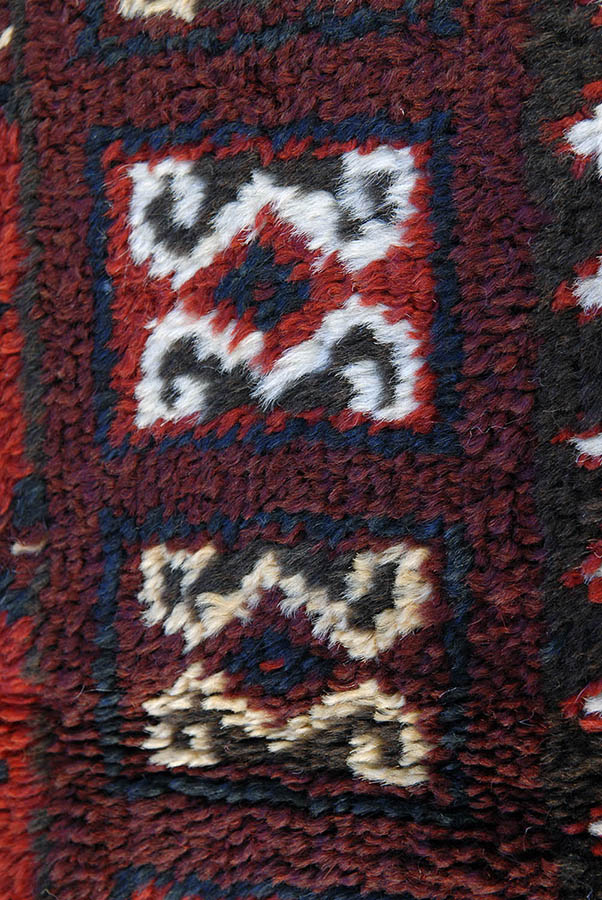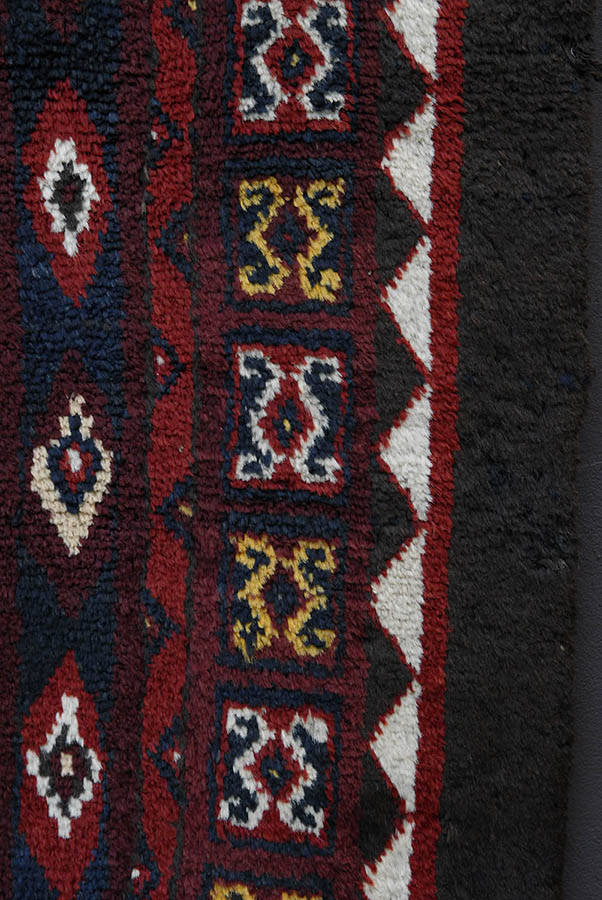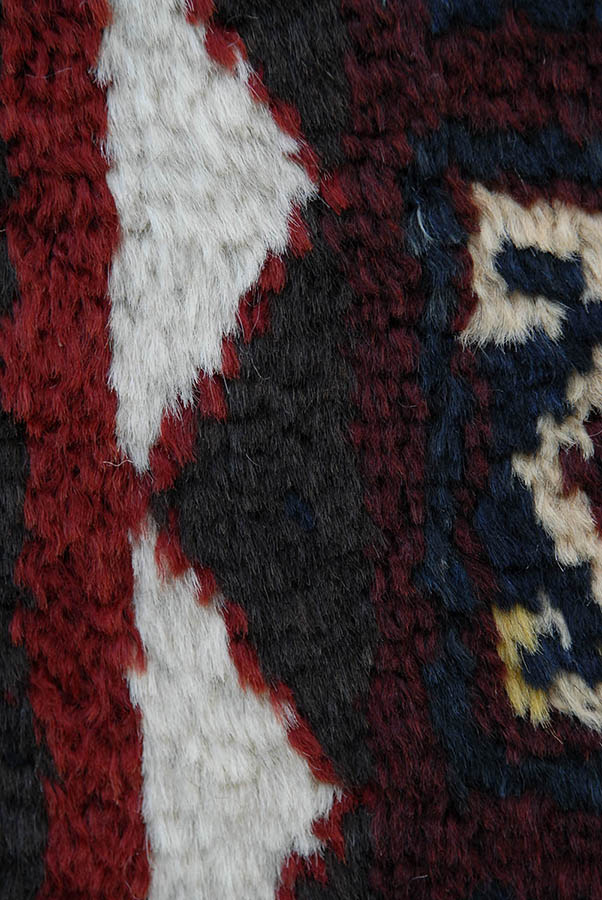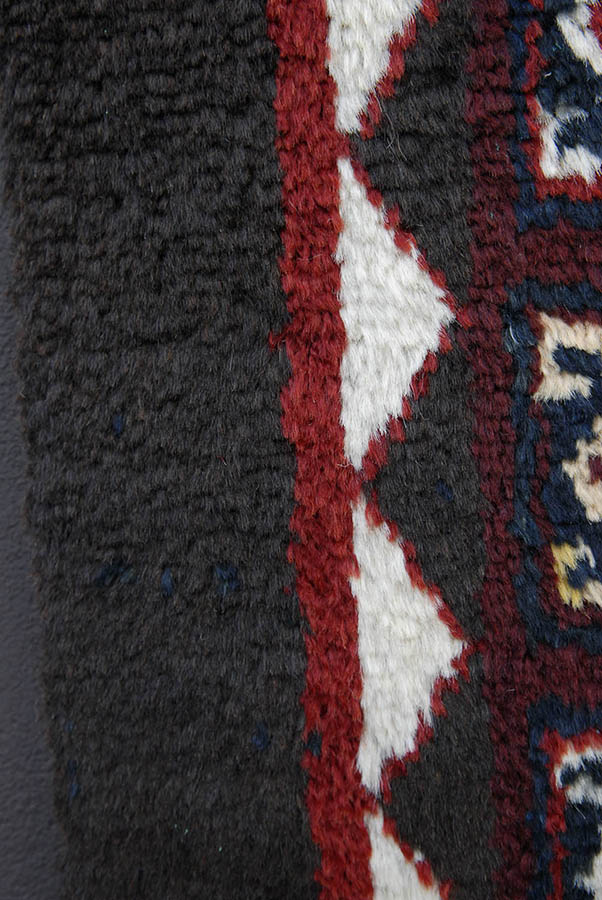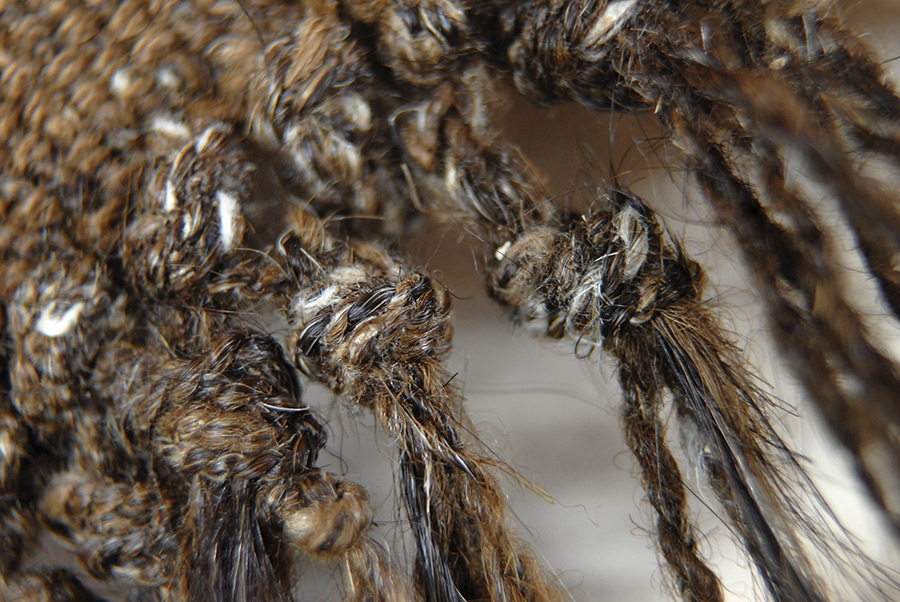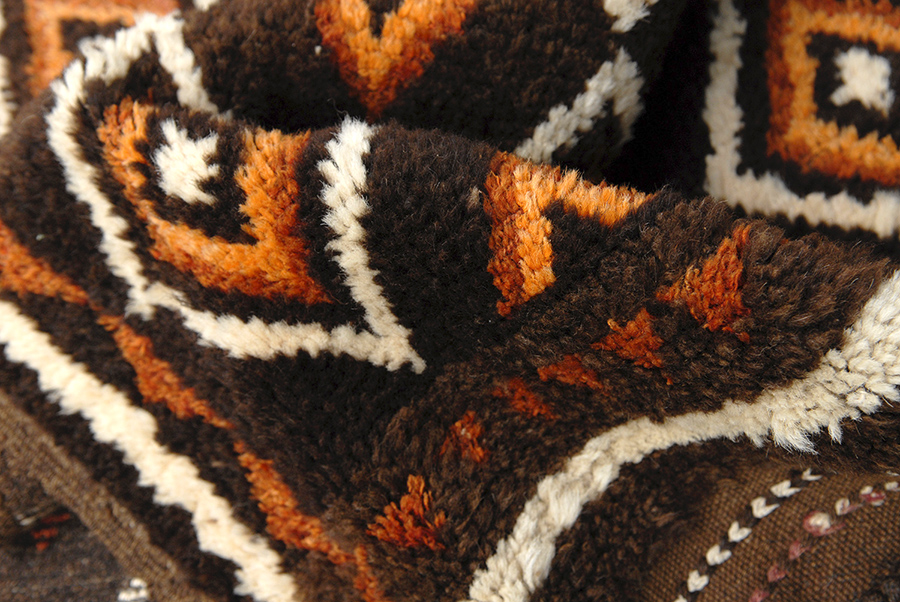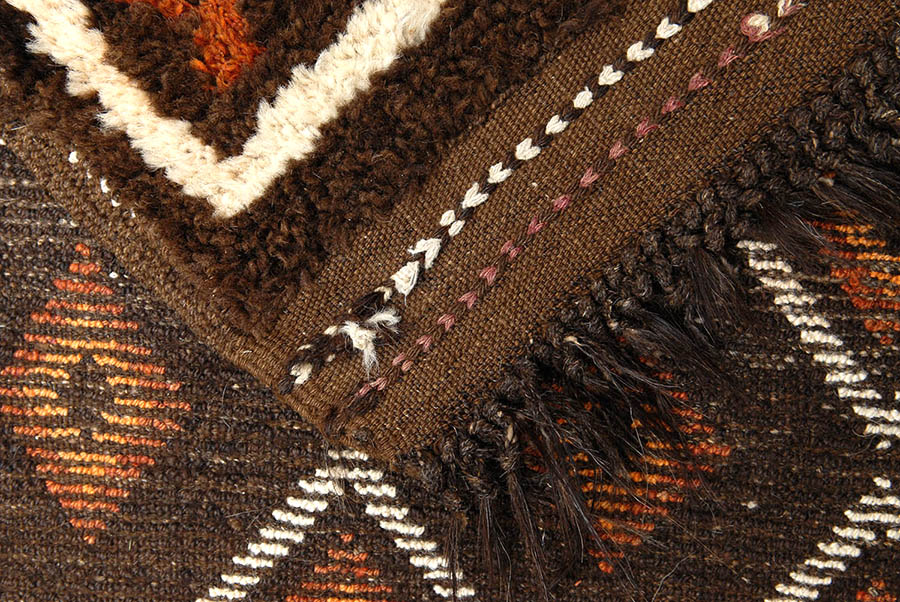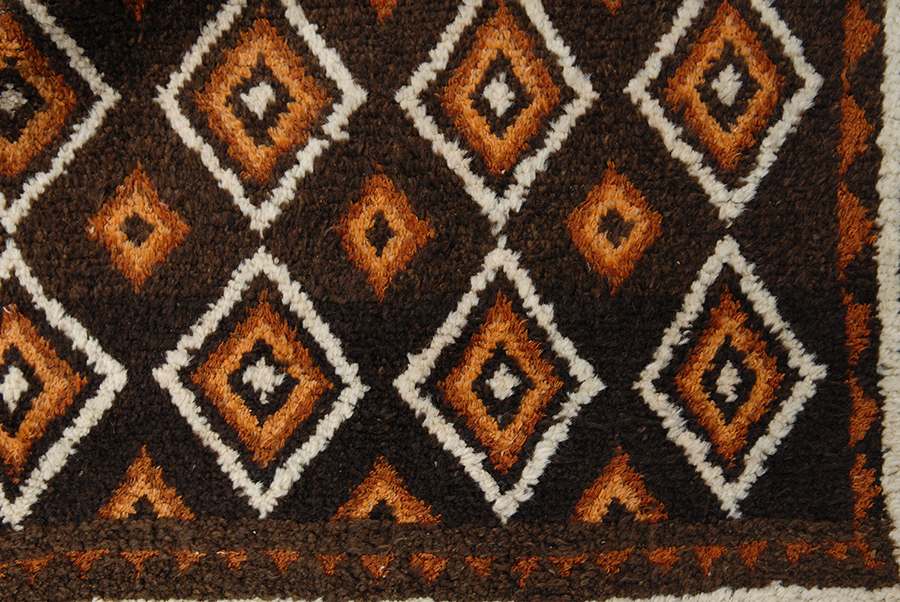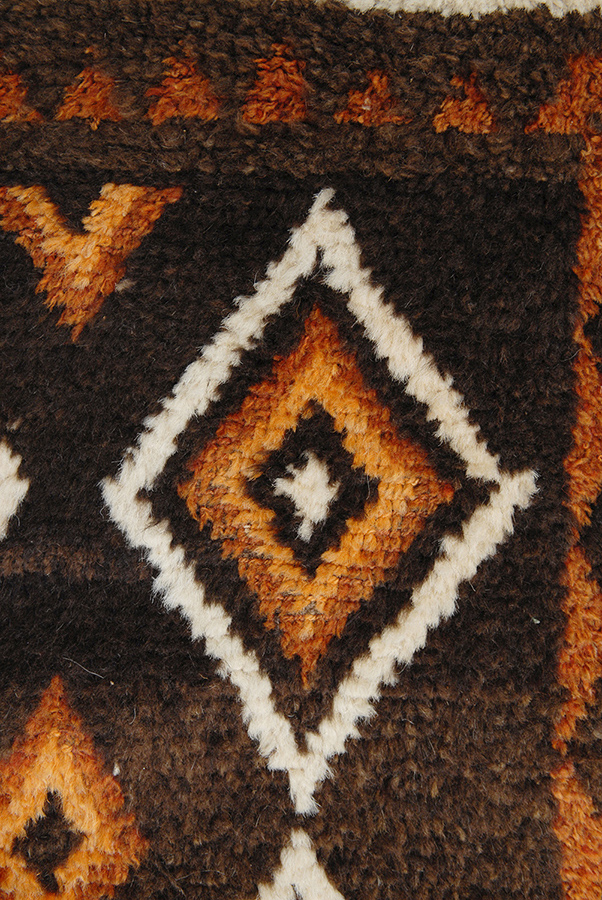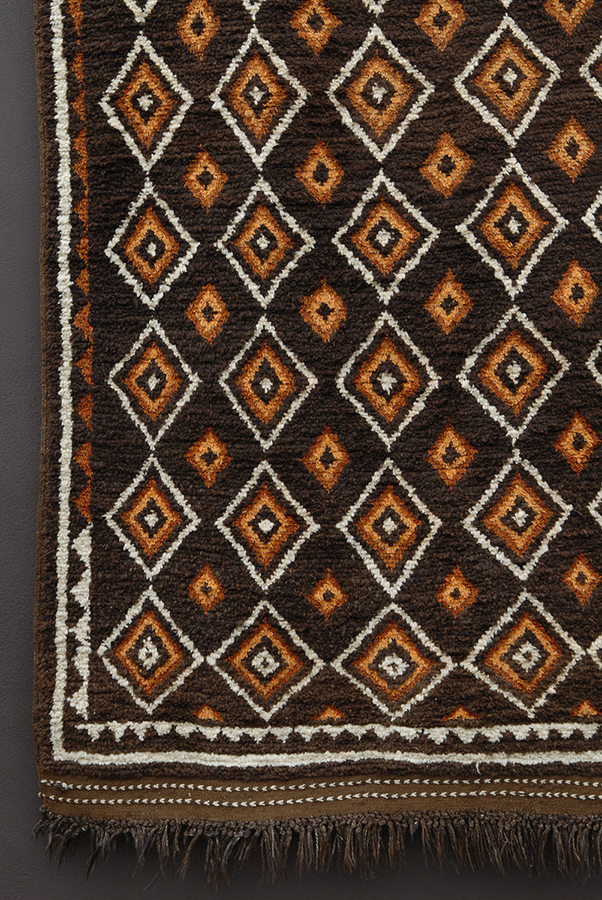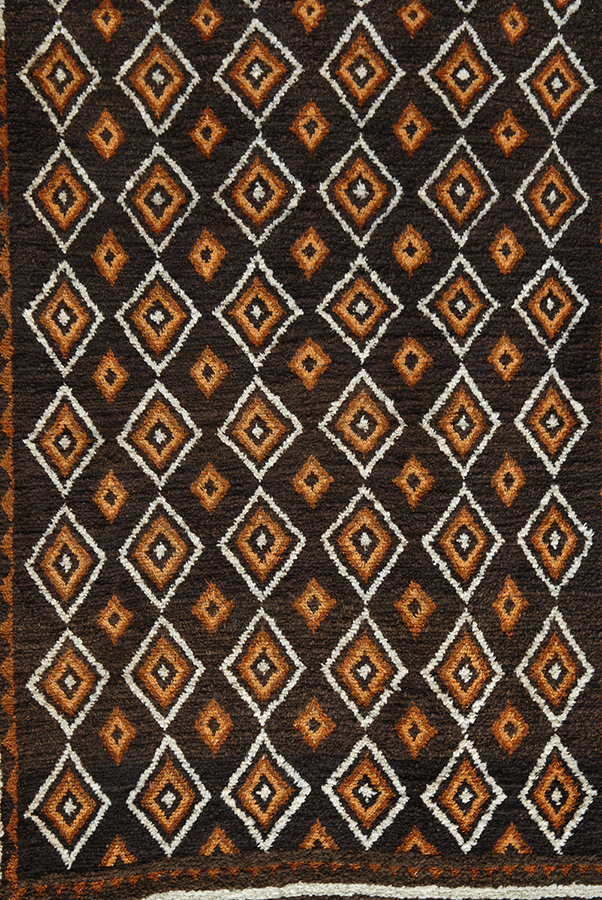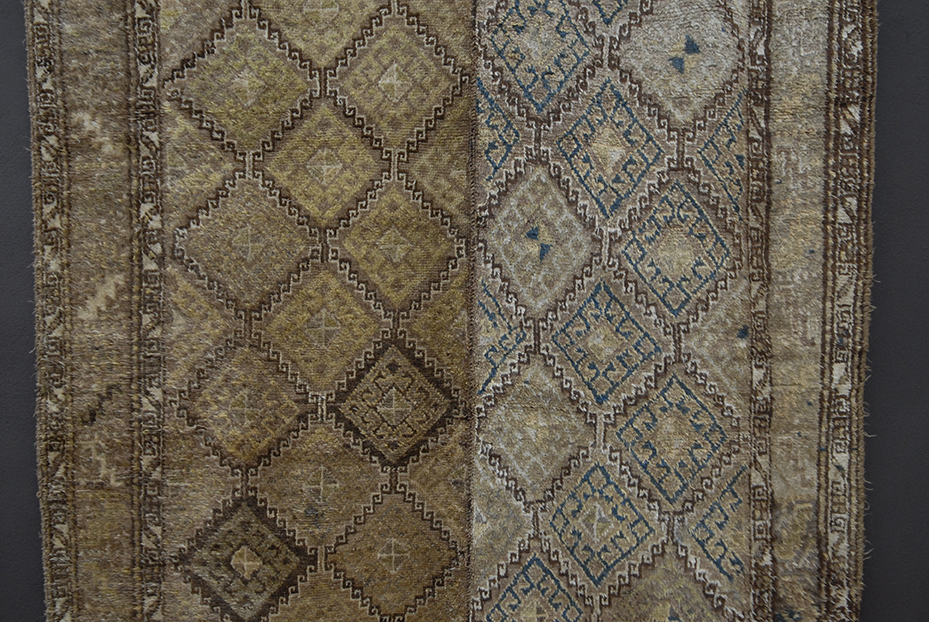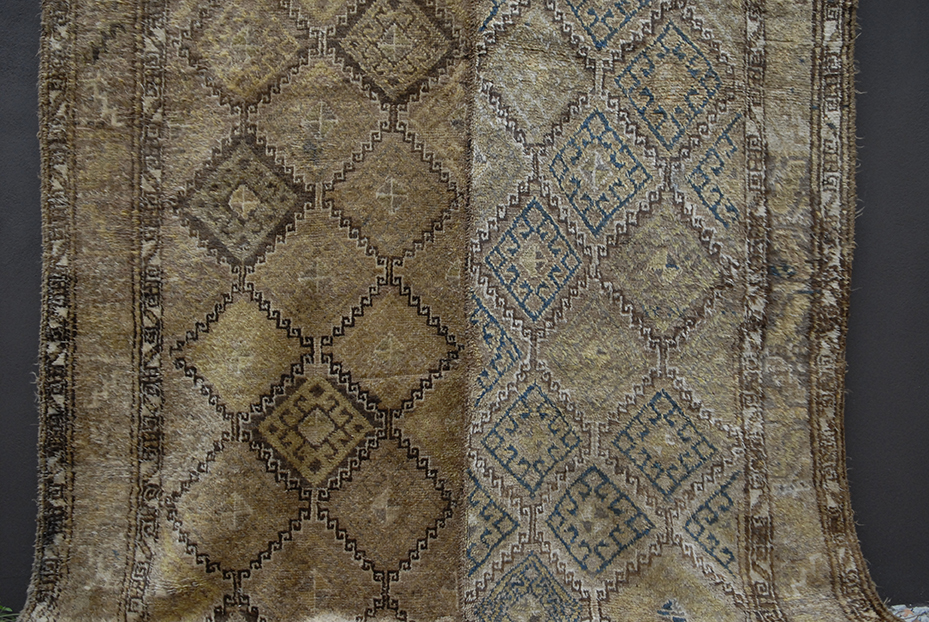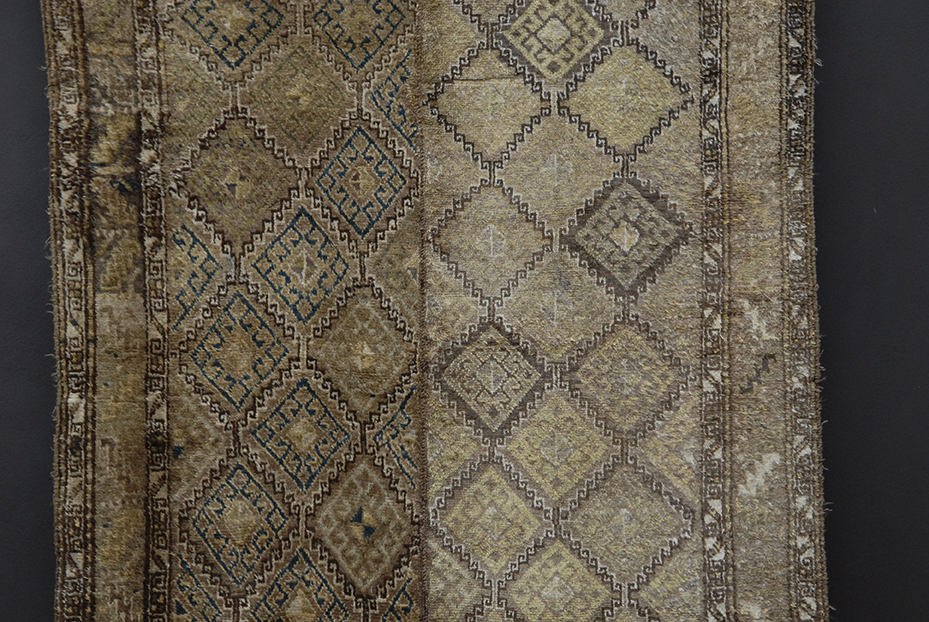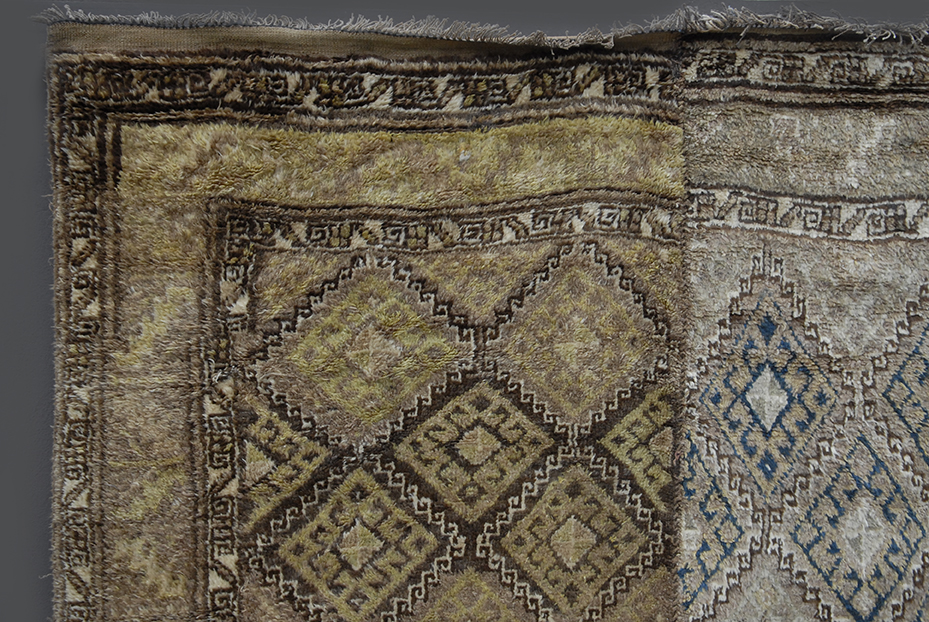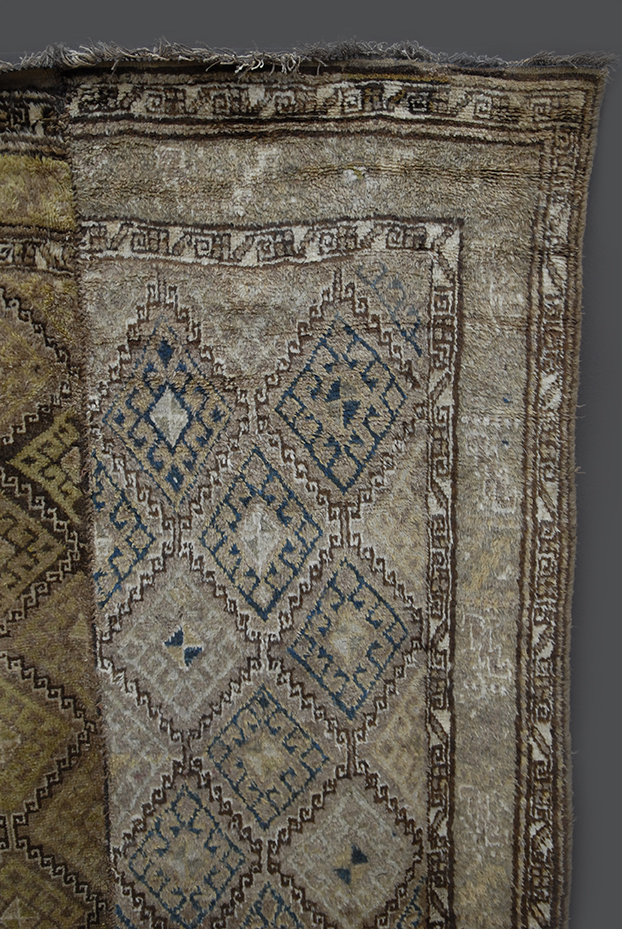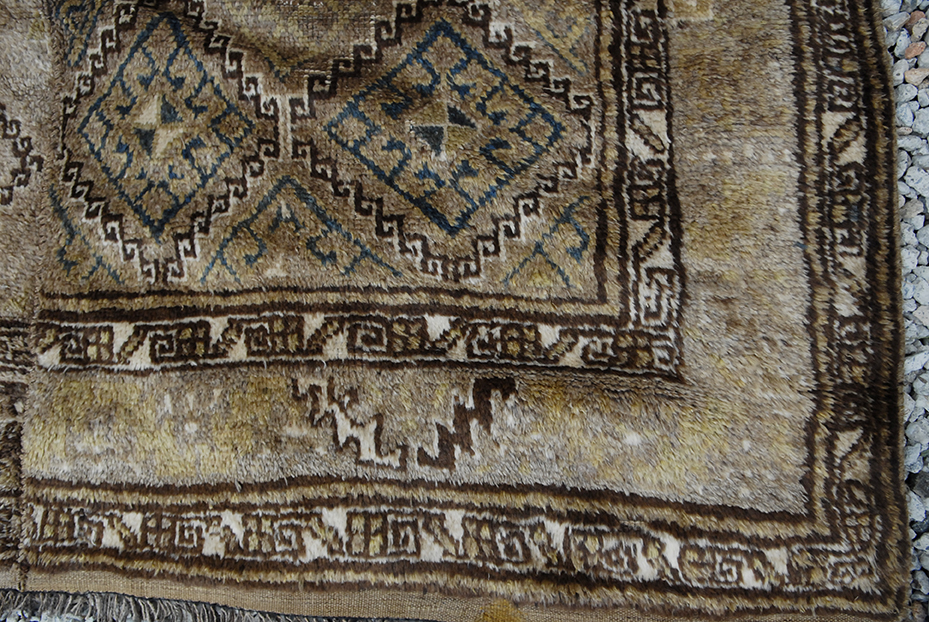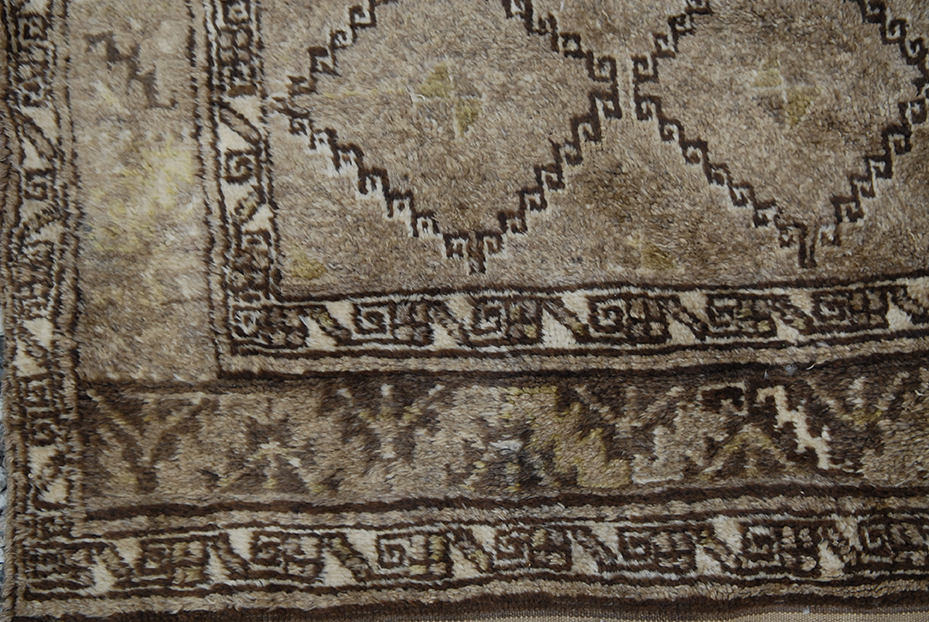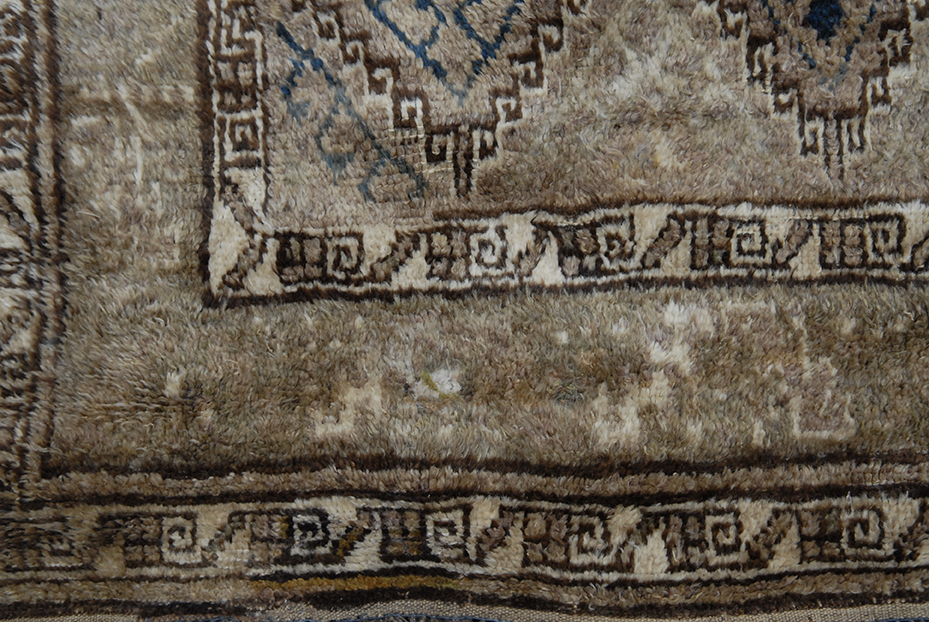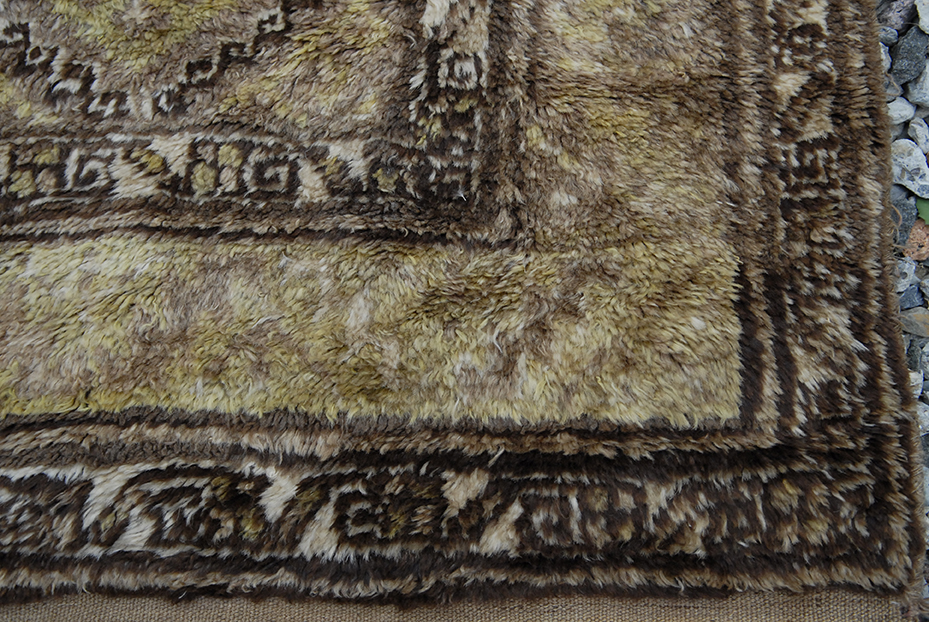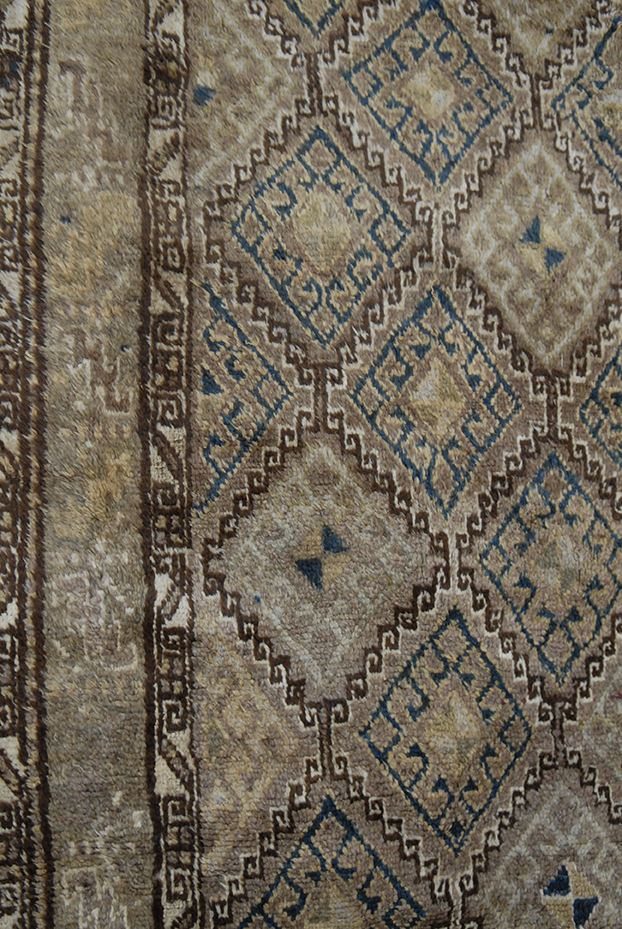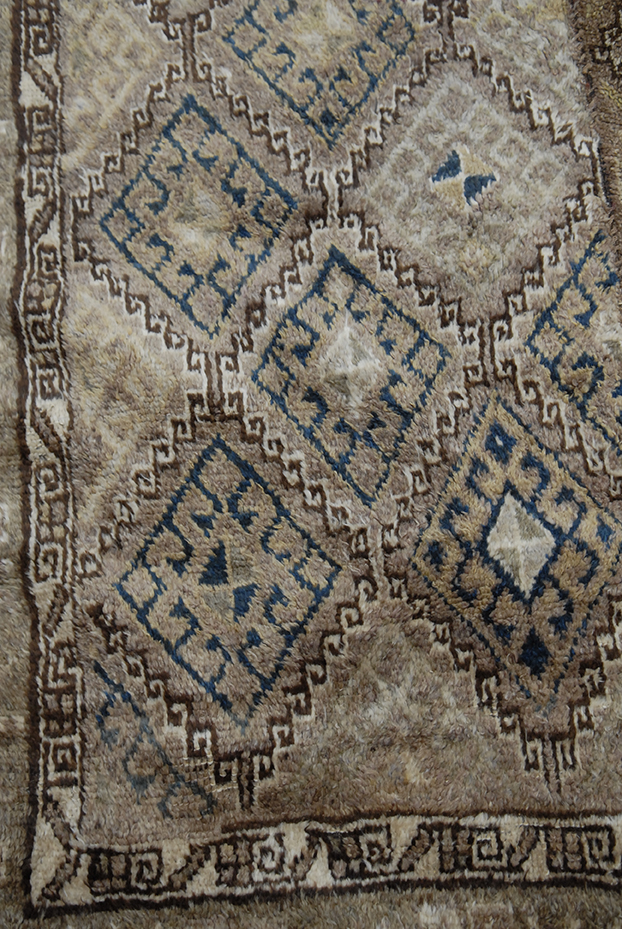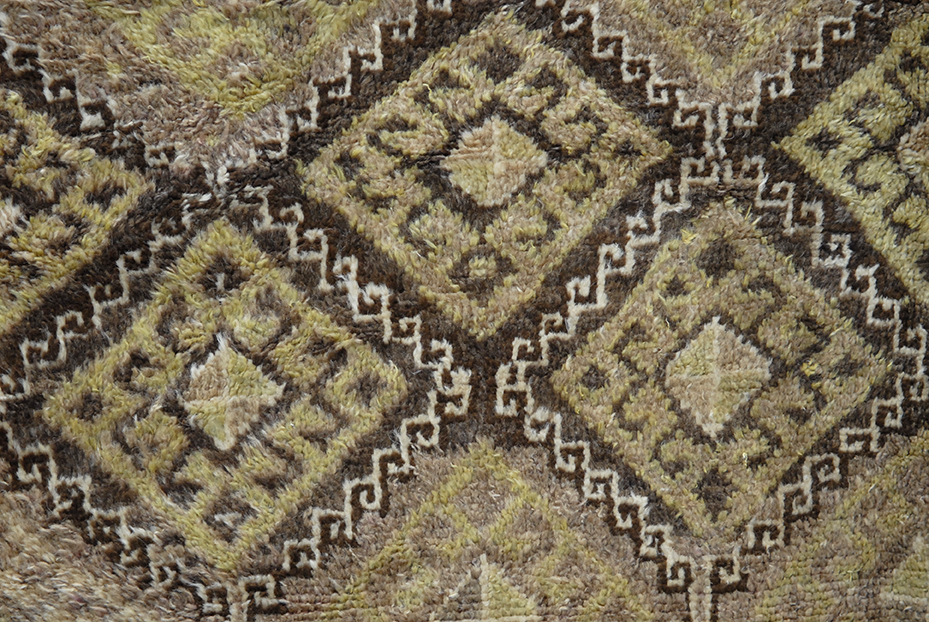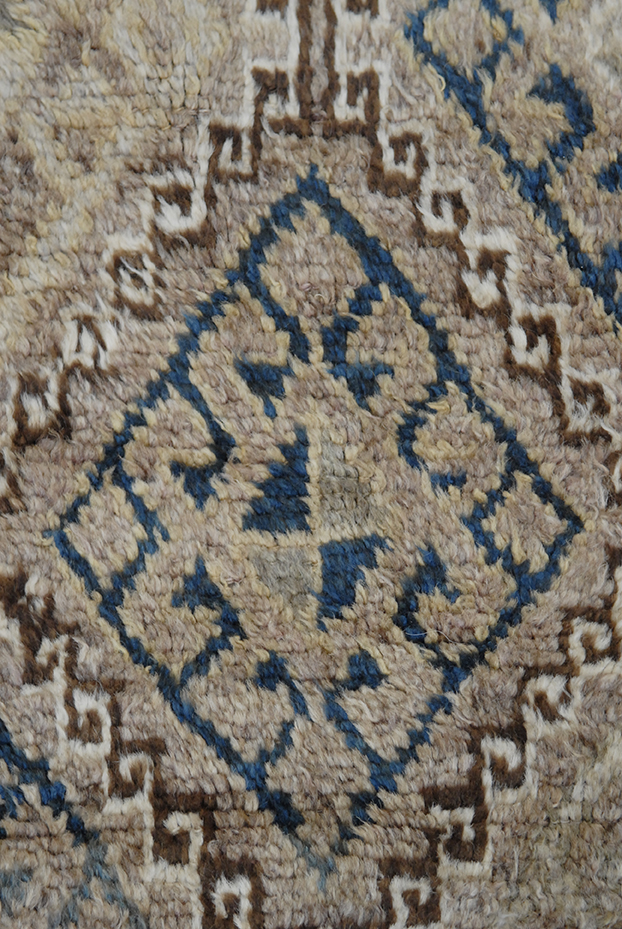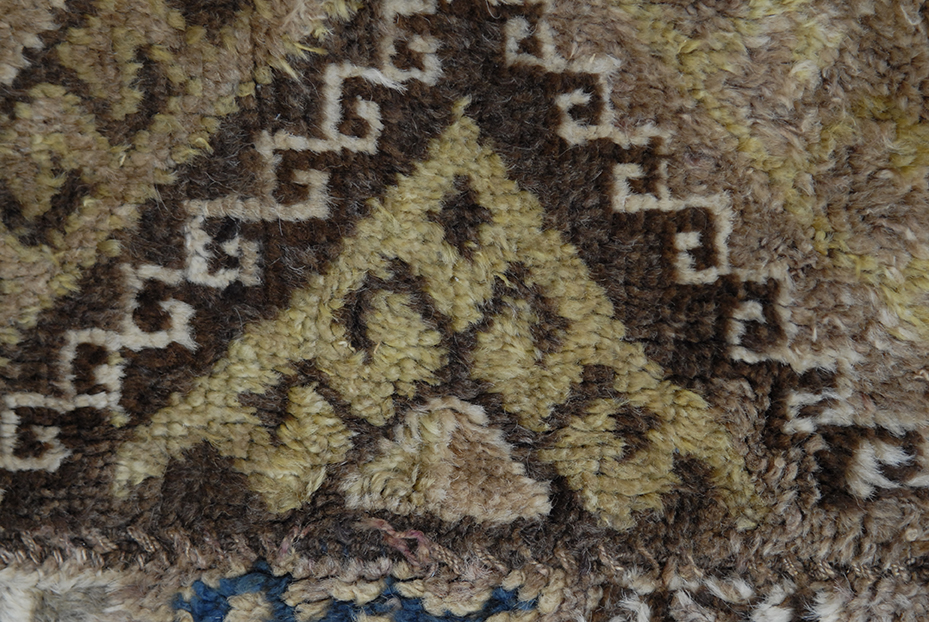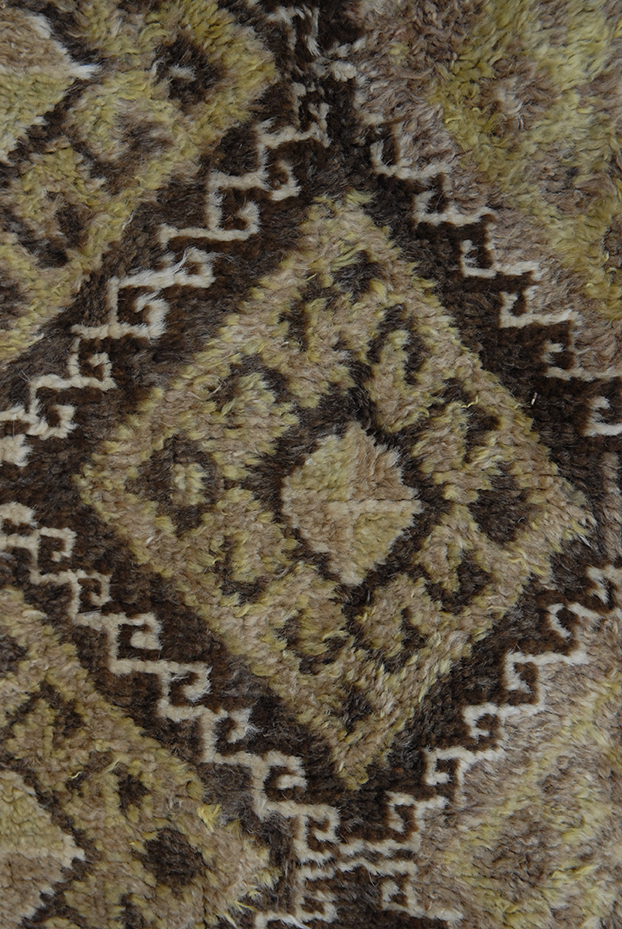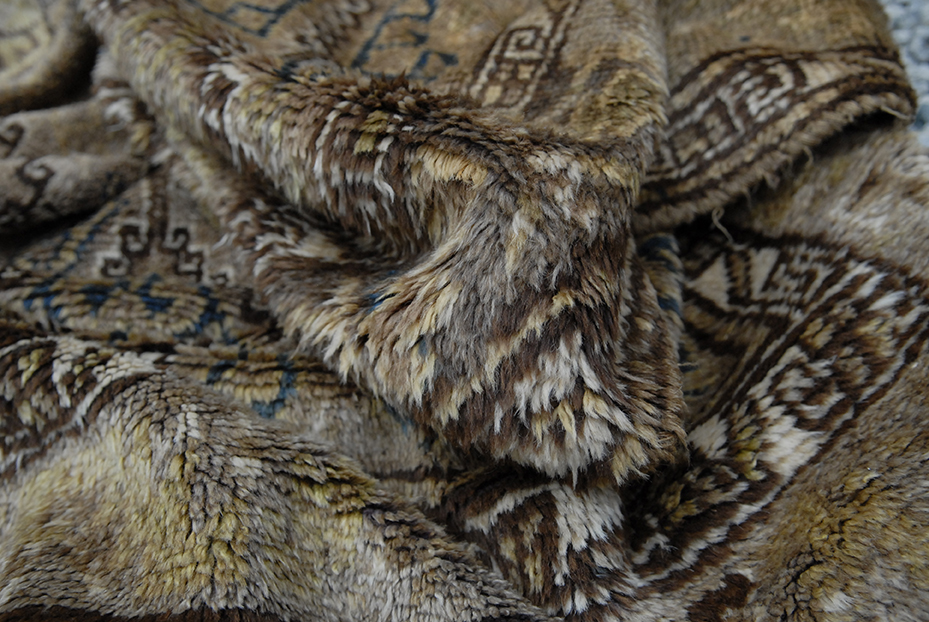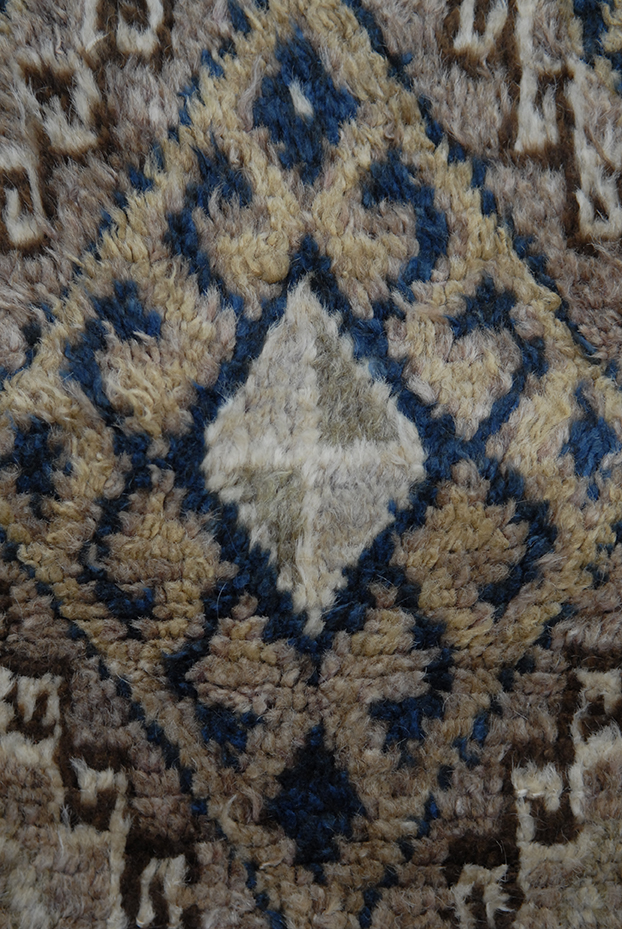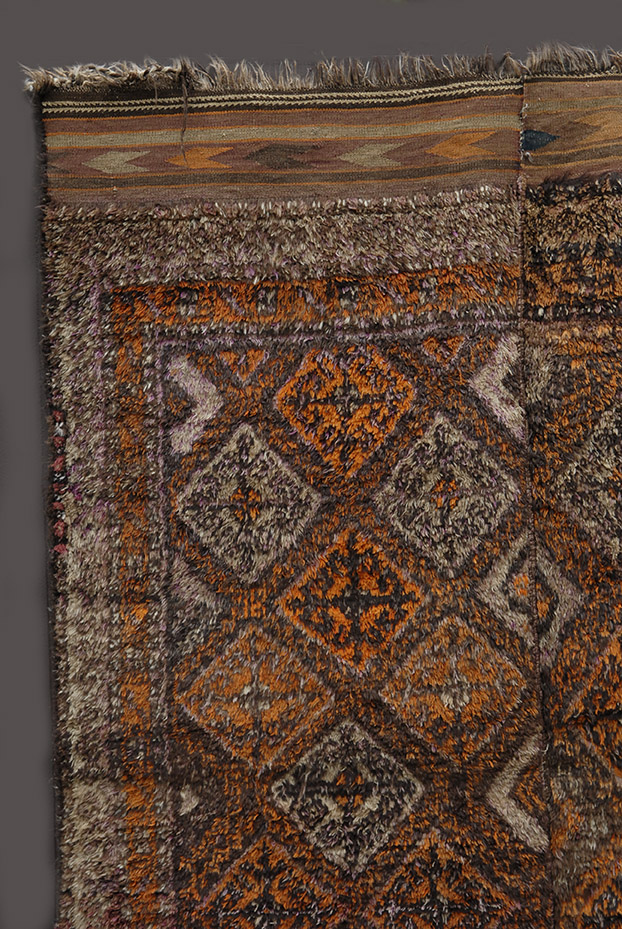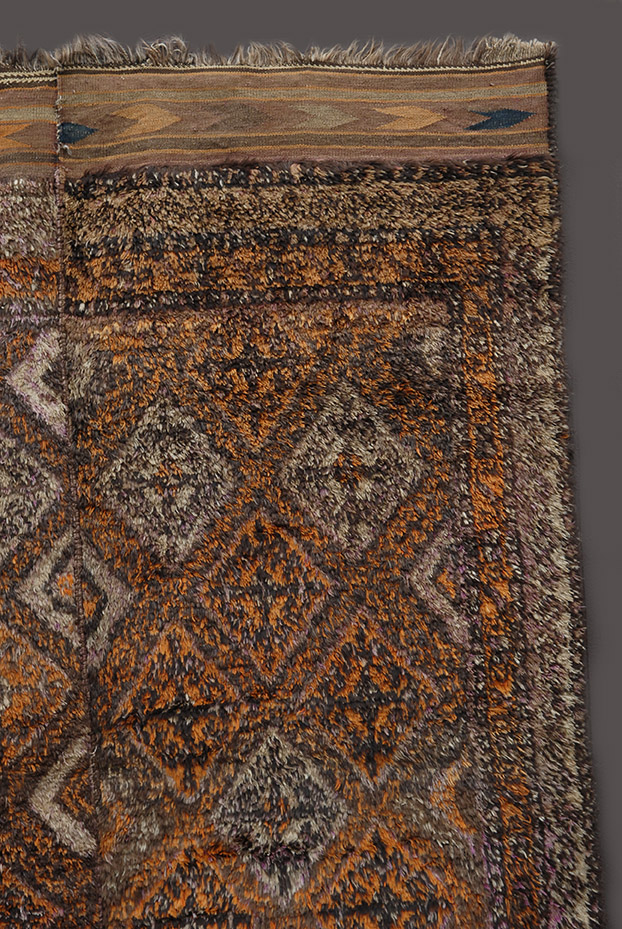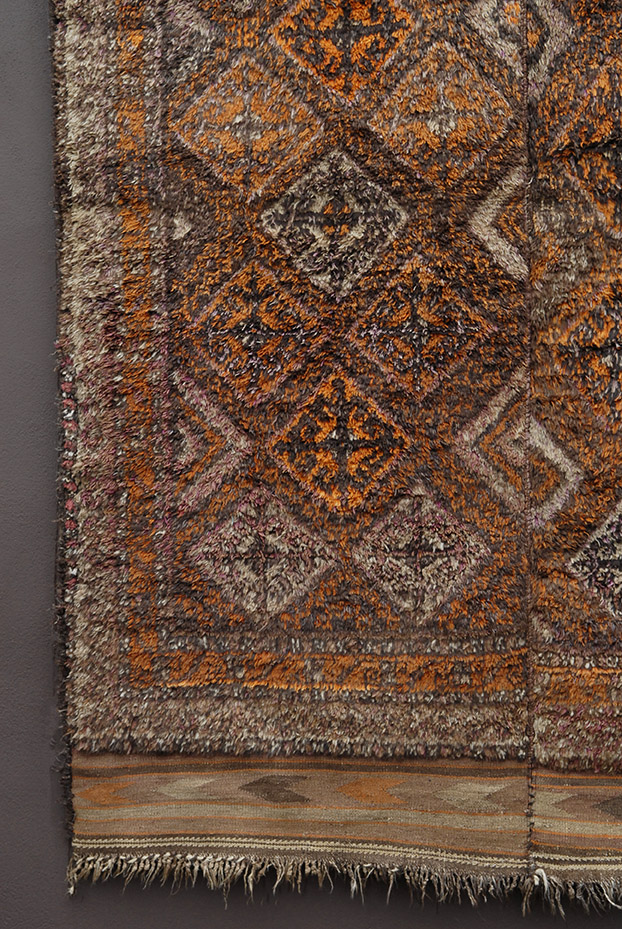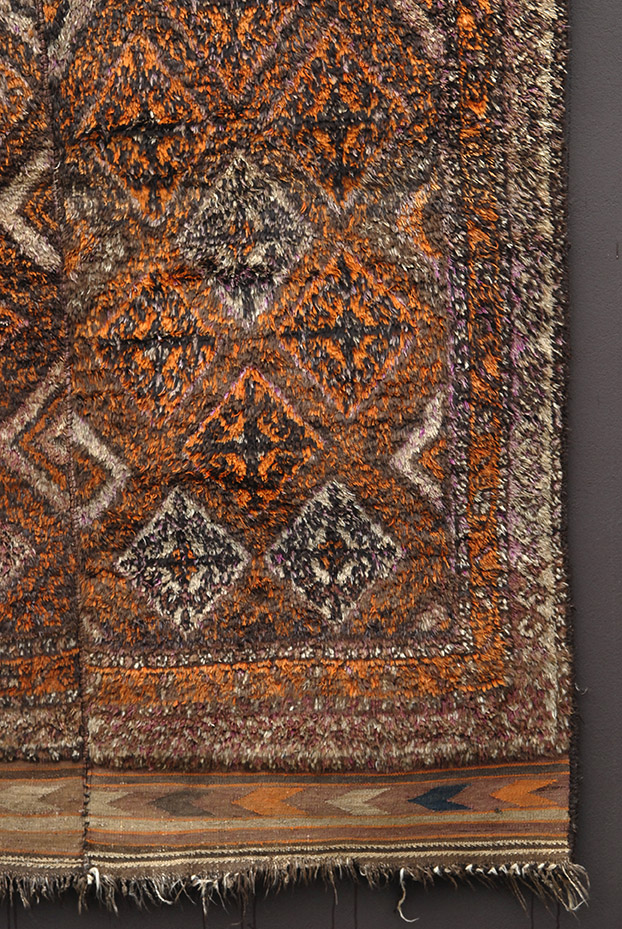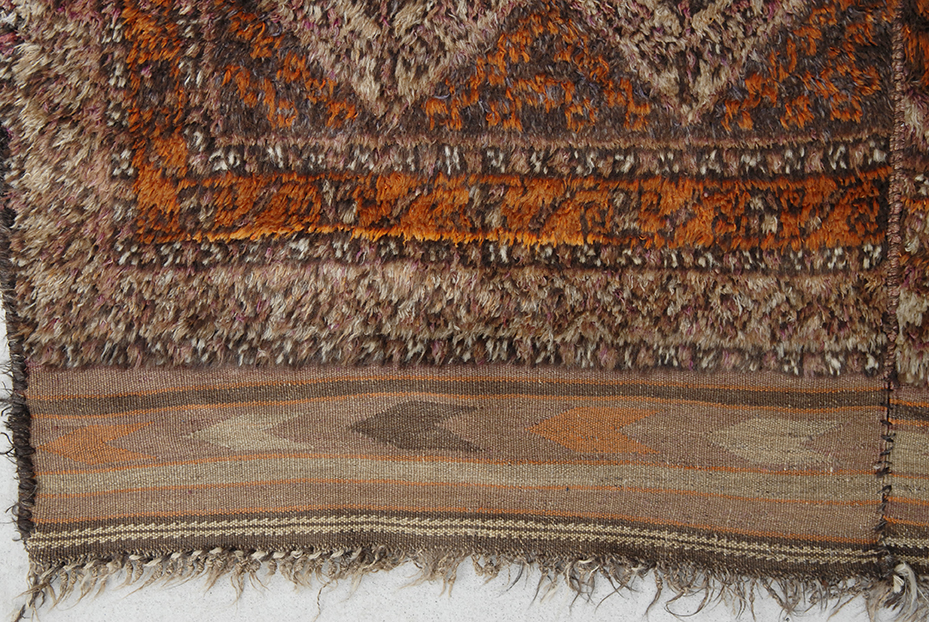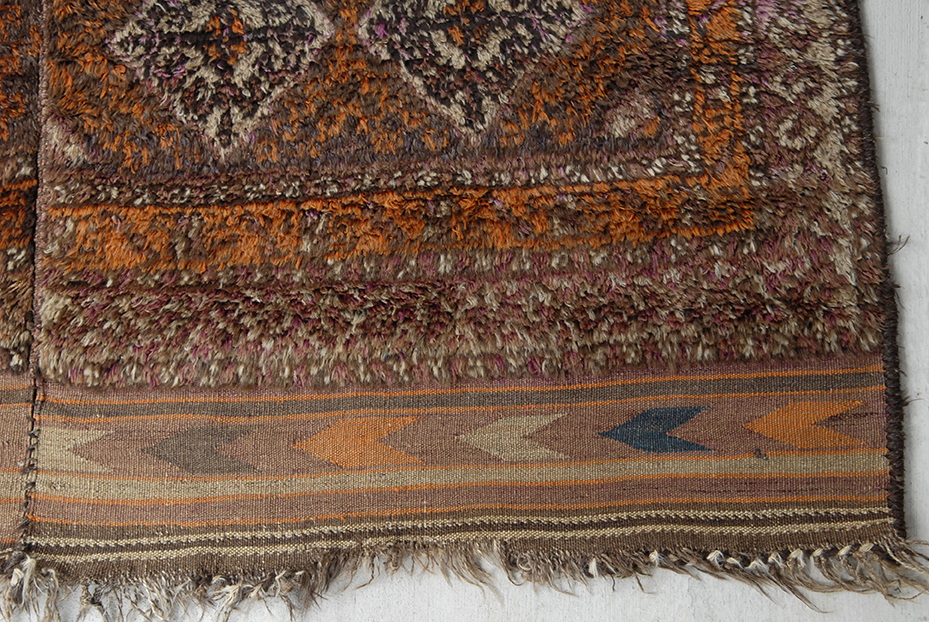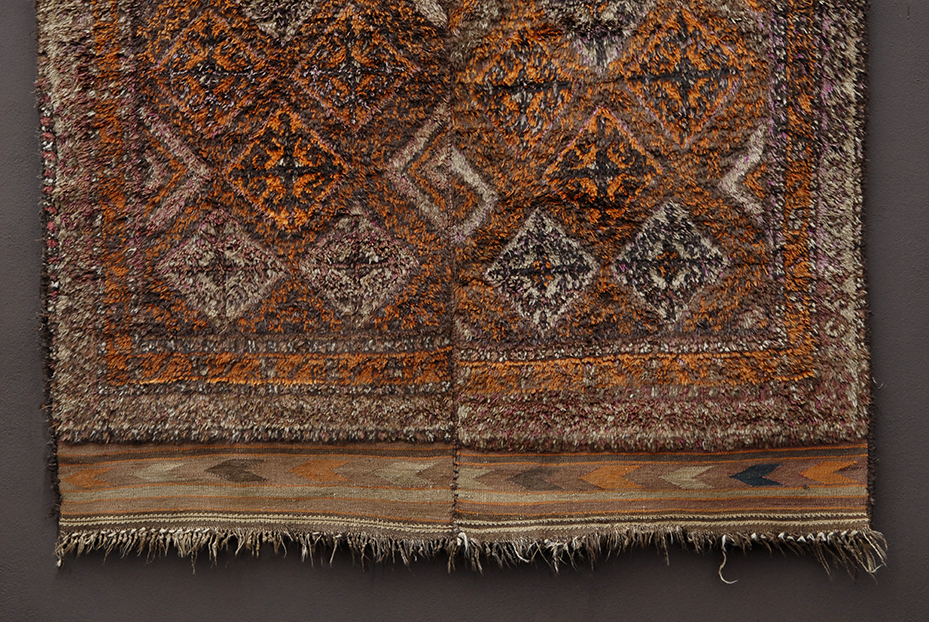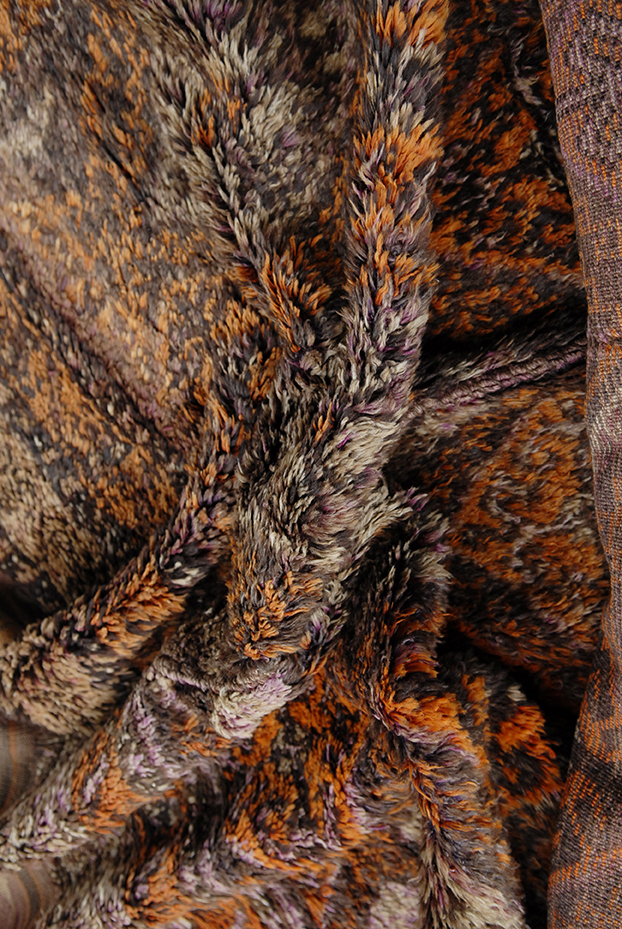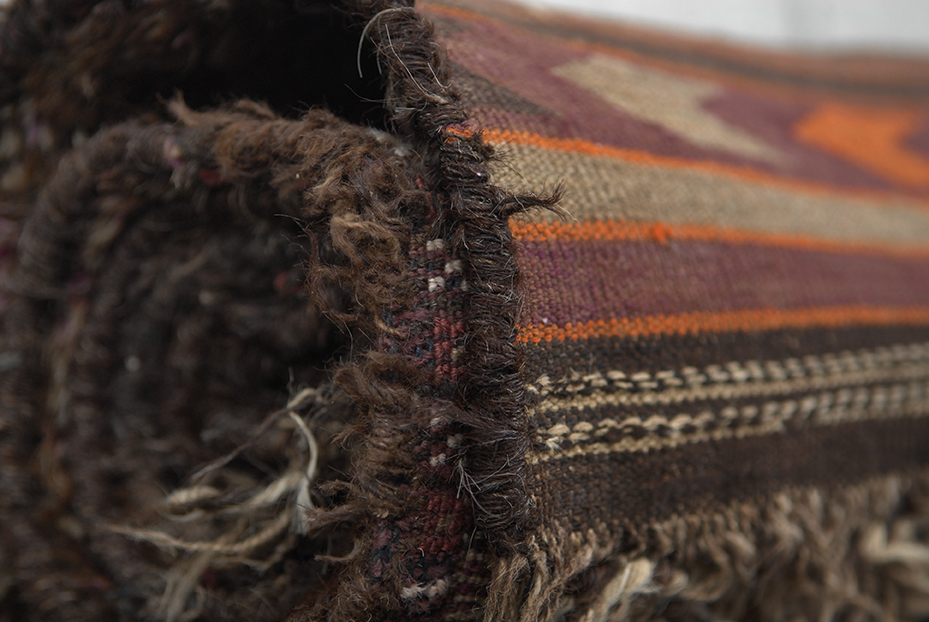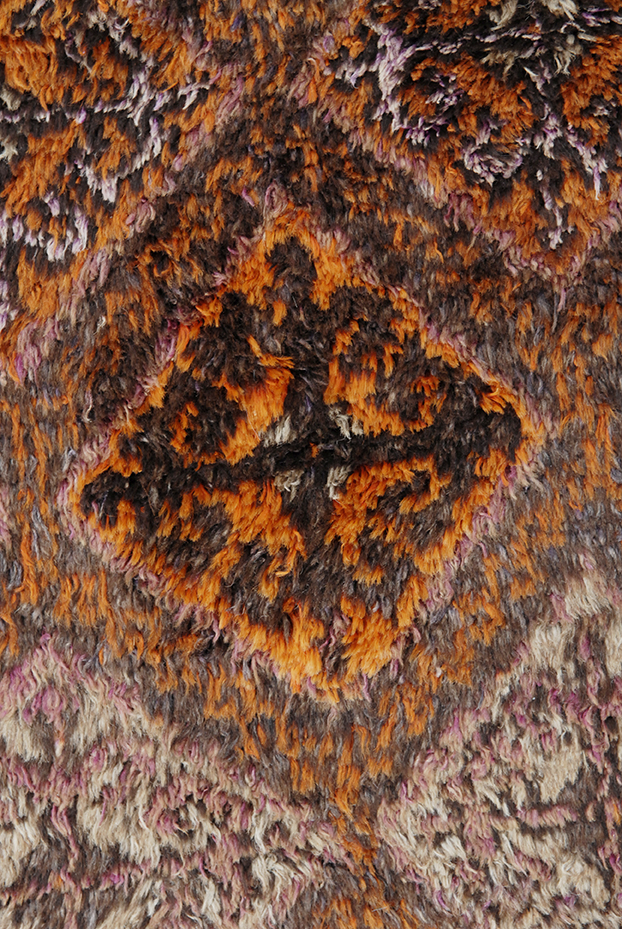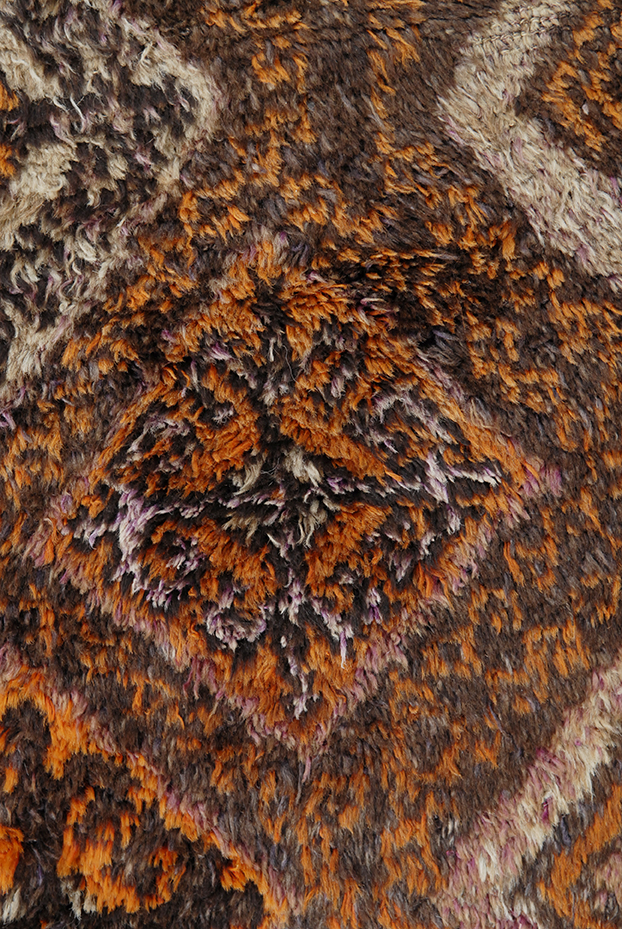RUGS
ALPUJARRA SPAIN ANDALUCIA
Alpujarra Spain, Andalucia Mid 19th Century
Looped pile Alpujarra. An abrashed turquoise blue green field – red and saffron yellow, aged patina with richly coloured geometric motifs two borders including a lattice outer border. Yellow red and turquoise fringe. Woven in two strips stitched together, areas of wear, some re-piling, old linen patches on reverse.
Warp: Ivory cotton. Wefts: 3 shots Ivory cotton “Pile Design wefts”: Looped wool Sides: Plainweave, extra turquoise weft Ends: Plainweave
This rug looks incredible as a wall hanging and will add vibrant colour to a room. More than a century and a half of history shows through with a unique abrash. The linen repairs are visible on the back but do not detract from the appeal of this rug when hung in the right room setting. Displaying bold motifs, the simplistic styling will lift the mood of any space.
More about Alpujarra rugs here : Alpujarra Rugs – Moorish Covers from Andalucia
228 x 167 cm
$2,300 AUD.
Heriz Azerbaijan
First Quarter 20th Century
Heriz Persia, Azerbaijan
Original selvedges, both ends minimally reduced. Mostly full pile with some slightly lower areas. Excellent original condition.
Relevant article describing Heriz rugs by Jan David Winitz President and Founder of Claremont Rug Company :
“With distinctive large-scale motifs and a wide ranging palette of warm colors, the antique Heriz carpet is probably the most popular of the Persian village carpets. In constant, increasing demand for the past decade, the finer old pieces have become scarce and have risen significantly in value and esteem.
These antique Persian carpets are named after the largest town in a district of over 30 villages, in the mountainous area of Northwest Persia, 50 miles east of Tabriz. The inception of the classic “diamond on a square” medallion Heriz was probably in the third quarter of the nineteenth century. It is believed that enterprising Tabriz merchants, wanting room size Persian carpets for export, showed local weavers the fine city rugs or maybe even scraps of fabric and asked them to weave large carpets. The weavers, skilled in the more spontaneous and angular weaving of tribal origin, adapted these antique carpet designs. The result, the Heriz carpet, is a marvelously effective hybrid, a rustic, charming village carpet with a richness and grandeur equal to the Persian court pieces.
The virtues of the antique Heriz carpets are found in their design style and color. The signature of a Heriz is the large medallion with overscale cornerpieces filled with angular oak leaves and foliage, at once bold and captivating. Older antique Heriz rugs, echoing the famousantique Serapi carpets from the same district, tend to be more spacious in design, while the Heriz rugs woven in the last 60 years tend to be more densely designed. Other formats more rarely seen include allover flower or leaf antique carpet designs and occasionally a “Tree of Life” motif reminiscent of some antique Caucasian rugs.
Once asked how she chose the colors to be used for her rug, a Heriz rug weaver pointed at the sunset that was just occurring. Certainly, the antique Heriz rug makers were consummate masters of vegetable dyeing. While the Heriz rugs of the last 20-40 years are often chemically dyed, with the best using a mixture of natural and chemical, older antique Heriz carpets tend to have been made with pure vegetable dyes. These have mellowed and attained a wonderful patina with age. The technique of abrash, or intentional variation within one color tone, is masterfully used in the finest antique Heriz rugs. The well-developed technique of double or even triple outlining, which also distinguishes the best Heriz antique rugs, creates remarkable strength and depth of color and design.
The better semi-antique and antique Heriz rugs used the lustrous wool from the Shahsavan, a nomadic tribe residing in the nearby Elbrus Mountains. Later, wool was imported from Tabriz, but it was always top quality and high in lanolin. They are quite loosely knotted, but employ a thick, sturdy cotton foundation with tightly packed knots, making for their well-known durability.
In home design, Heriz carpets are beloved for their versatility. Their geometry complements modern furnishings and their warm colors and artistic depth enhances antiques of all kinds. Their richness of color and strength of design make them a common choice for corporate settings as well. Exemplary Heriz Persian rugs make an excellent investment carpet because of their artistic individuality and enduring appeal.”
280 x 208 cm
$5,500 AUD
Large Uzbek memling gul Rug from north east Afghanistan, possibly badakshan
Large Uzbek rug woven in four strips stitched together, 1st Quarter 20th Century. Natural dark brown wool outer border. The outer rams horn border is made up of positive - negative rams horns in yellow and white. A third border with repeated rhomboid motif and rams horn inner border in natural cream-white wool pile.
The field contains eight large “Memling Guls” in natural white plus cream wool. Contrasting against red and a vibrant indigo. The guls are set against a deep reddish aubergine ground.
There are good, creative repairs in the rug, but not much sign of wear.
305 x 197 cm 14kg
If you see this Uzbek rug listed here, it is still available. Shipping from Brisbane Australia. Price $2,600 AUD. More images here.
Uzbek One Piece Goat Hair Foundation Wool Pile
Uzbek Rug
One piece Uzbek rugs from southern Uzbekistan and the north of Afghanistan are rare compared to Julkhirs rugs which are woven in several strips. This rug resembles early Uzbek Julkhirs one-piece rugs, or so-called Darya Uzbek one pice long piled rugs. The type of rug illustrated here is usually woven with a goat hair foundation and pile of either wool or goat hair.
This example was woven with pile of natural brown and white wool plus orange dyed wool.
230 x 142 cm 8kg
$1,400 AUD
Massive Two Piece Long Piled rug
Nearly all natural wool colours have been used to created the earthy light toned hues of this large two piece bedding rug. Dark blue - Indigo and yellow dyed wool has been sparingly woven into the pile of this rug, creating a subtle contrast to the natural wool colours of tan, white, brown and grey.
The repeated lattice rhomboid shaped field is defined by a "running mouse" brown and white border, surrounding simplified versions if repeated vase motifs. Each of these rhomboid shapes has a central “Mah” or Moon motif. With a large recumbent S border.
This bedding rug was created in an extra large size, double the length compared to other examples and probably used outdoors or in tents, for large gatherings. In the right sized room, this rug would be a spectacular compliment to modern architectural styles. Second quarter 20th Century.
438 cm x 189 cm
$2,600 AUD
Large Two Piece Orange Taimani Beautiful Kilim Ends.
Probably Ghor province Circa 1930.
Goat hair and wool warps, goat hair over binding to selvage. Vivid orange pile, combined with un-dyed wool colours. Thick lustrous wool, long pile. Wide kilim ends with bold graphic design seldom seen on Taimani bedding rugs, some of the original white and brown twining intact.
230 cm x 170 cm
$1,600 AUD
Arab Jukhirs Circa 1900 Indigo with MADDER
Early Arab Julkhirs Long Shaggy Pile, indigo and madder.
Woven in four panels, each panel dip dyed then stitched together. This Julkhirs rug is pure nomadic minimalism. Showcasing this traditional weaving technique, carried forward for generations from the stone age. A product of the Central Asian nomadic environment, where these Central Asian nomadic rug makers roamed. The sparse design is now the embodiment of that place and time. This textile art cannot be repeated, during the twentieth century lost to wars, social upheaval and shifting borders.
Deep vibrant indigo dyed side panels with madder central panels. All natural plant dyes accented by the long, soft and luxurious wool pile.
Woven on a narrow beam loom, using the highest quality wool from nomad raised Karakol sheep. Wool foundation with a warp faced back.
290 cm x 100 cm
$1,200 AUD
19TH CENTURY QASHQAI RAHIMLU TRIBE WEDDING DOWRY RUG
FINE ANTIQUE QASHQAI WEDDING DOWRY RUG, 2ND HALF 19TH Century RAHIMLU SUB-TRIBE, CLASSIC EXAMPLE, Exceptional Design. Fine antique rug by the Qashqai tribe of South West Persia. This excellent weaving is probably a wedding dowry piece, indicated by the couple who are drawn in the centre of the rug. This is a particularly fine weaving, which can be attributed to the Rahimlu Taifeh (sub- tribe) of the Qashqai. The attribution is based on the major border, which is unique to Rahimlu weaving.
The field design is a flowering floral lattice containing many well drawn 'lion masks'. The spandrels, which are reciprocated along the sides of the field, contain both floral design and 'lion masks'. Both ends have unusual end finishes in that the usual checker-board design has been replaced with a chevron design.
The colour palette is excellent with rich, natural, fully saturated dyes. The top of the rug has a heavily abrashed area, as can be seen in the images. The weaving is very fine, and the drawing is excellent; indicating that this rug was woven by a most accomplished weaver. A highly collectable rug in excellent condition.
The condition is excellent, with even wear throughout. The side cords are original and have been rebound.
There are a number of old reweaves to the field, which are well blended and difficult to detect. The ends have been secured and the rug has been professionally hand washed.
2nd Half 19th Century
277 cm x 168 cm
$8,000 AUD
Eastern European RUG WITH LARGE CENTRAL MEDALLION
Romania, Ukraine or TURKISH VILLAGE RUG
Mid 20th Century village rug, hand woven. Large central medallion, possibly a family crest. A very rare rug never available online or in stores. This is a unique example of village folk art, made for the weaver’s personal use.
Woven into the rug on either side are two small loops. This indicates the rug could have been an important household item, able to be displayed as a wall hanging.
There are multiple wefts between the rows of knots, which are visible on the back of the rug. The technique is similar to that used by Turkish Tulu weavers.
The rug consists of three panels, each woven separately then sewn together. The central medallion is set into a deep crimson field, the medallion has an inscription consisting of two characters. The wide border is woven using natural black and dark brown un-dyed wool for the field, highlighted with a stylised floral design.
Dyed wool colours are blue, red, green, cream, orange, and brown. The dyes used are synthetic, this can be seen in tip fading of the dyed wool, the base of the wool knots still retain their original vibrant colour. The black wool used on the border is natural.
The condition of the rug is excellent, the original end fringes are mostly intact, there are two small repairs. Full pile throughout.
277cm x 168 cm
$650 AUD
TAIMANI RUG CENTRAL AFGHANISTAN LATE 19TH CENTURY
Finest quality long piled rug, late 19th Century. This rug is a rare example that defines this group of rugs. Woven by a wealthy nomadic group with access to better resources than other nomadic groups in their region.
The natural dyes have been worked by a master of the use of natural pigments and plant dyes.
Dyed colours include saturated bottle green, vivid sky blue to indigo with orange and white contrasts. Intense shades of madder compliment natural brown wool colours.
Woven with the highest quality, soft luxurious wool with thick long pile.
240 cm x 185 cm
$5,500 AUD
THE SHAGGIEST MOST DENSELY PILED, LONG PILE RUG YOU’LL EVER FIND.
Taimani, first quarter 20th century.
This Taimani rug was woven in two separate pieces then the two halves stitched together. The nomadic weavers packed the long knotted pile so tight they managed to weave a rug which defies logic. Sit on this rug and you gently sink into the long soft pile. Usually long piled rugs require either warp faced foundations, some with multiple wefts between the rows of knots. Look at the images of the back of the rug and you can see clearly the “water carrier” motif is the dominant and repetitive design device, showing the tightly packed wefts. The colours are a mixture of naturally dyed pile wool, some natural un-dyed wool colours and synthetic dyed colours. The colour palette shows a range of earthy tones from the natural wool colours, subtly combined with dyed wool colours. Look closely at the images and this colour range provides a mesmerising view into a unique nomadic work of woven art. The colours appear to shift at each viewing angle, and in different light the depth of tone and colour gives this rug an appeal like no other. The corded selvage is over-bound with very thick and rustic natural brown wool. The kilim ends are long and intact, with natural dyed light aubergine twining. The rug is in remarkable condition for it’s age and has to be seen in person to feel the full effect of it’s unique qualities. You simply cannot compare this rug with any other in this group of long piled rugs from central to west Afghanistan.
The sheer volume of wool used is another unique attribute. Weighing in at 23kg, most rugs that cover the same area weigh about 10kg less. This rug requires special shipping arrangements and won’t ship via our normal carrier, Australia Post. Please email for more details on shipping.
220 x 199 cm
$4,500 AUD
LARGE GOAT HAIR RUG
Ultra soft dark brown goat hair pile. The natural goat hair is bound tightly into the foundation, allowing the natural fibres to remain in their natural state. This allows the rug to appear as if it is the living hide of the animals that it was sourced from.
White wool rhombus outlines and natural dyed light purple highlights.
Probably an Uzbek rug, although these rugs have also been attributed to Kirghiz weavers of the Afghan Pamirs mountains. The generic term Maldari, referring broadly to nomadic pastoralists has also been applied to this group of rugs.
Another view, from Milton Cater, is that Maldari is just the word that the sellers in the bazars use to describe Kuchi who are pashtun nomads, mainly in the Oruzgun province.
Whichever group wove this rug, the goat hair is incredibly soft to touch. Restrained primitive design, skillfully executed.
311 cm x 150 cm
$3,600 AUD
late 19th Century Uzbek rug uzbekistan samarkand
Uzbek nomads of the Fergana valley were actively trading in Samarkand during the 19th century. Their long piled rugs were bought and sold in the markets of Samarkand. Photographic evidence shows these long piled Uzbek rugs being used on the streets as sitting rugs. Sometimes on the hard cobble stone lined roads where outdoor lessons took place. The long soft pile was comfortable for sitting, which made these rugs popular. The designs were sometimes inspired by the ikat weavings of Samarkand, as well as other well known Uzbek motifs.
There is a well know image of a fabric merchant who is seated on two folded Uzbek julkhirs rugs.
The fabric merchant of Samarkand. Seated on Uzbek julkhirs rugs. Made by Uzbeks of the Fergana valley.
This Uzbek rug includes all natural dyed colours. Vivid colours are set against a ground of varying hues of madder coloured wool. The dyed colours consist of yellow and shades of indigo. Contrasted with natural wool. A dark brown border and white wool highlights are paired with light brown wool. The combination of natural colours is masterful.
The appeal of these Uzbek rugs is bound up in hundreds of years of design evolution, influenced by a close connection with the land and their herds of animals. Survival, living in a harsh environment influenced the practical aspects of creating these rugs. Made up of three, four or even five strips, woven separately, then stitched together. The narrow looms could be laid out on the ground, then picked up and moved to the next camp site.
340 cm x 136 cm
$3,600 AUD
late 19th Century Uzbek rug FRAGMENT
This Uzbek weaving is offered in the form of a fragment. There are many holes in the rug requires many repairs.
340 cm x 136 cm
$850.00 AUD



